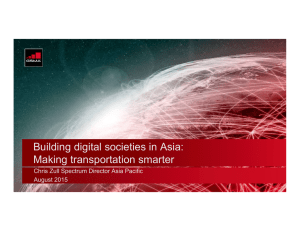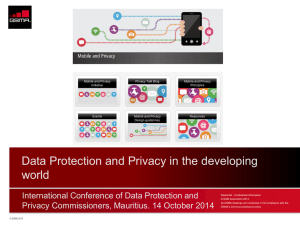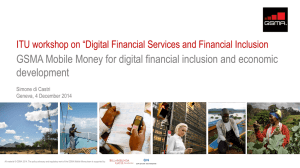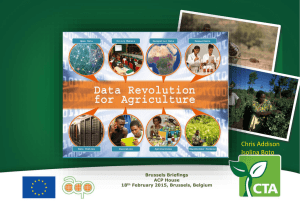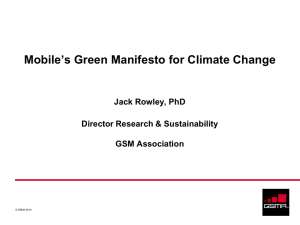Smart Sustainable Cities Trends and Real-World Opportunities
advertisement
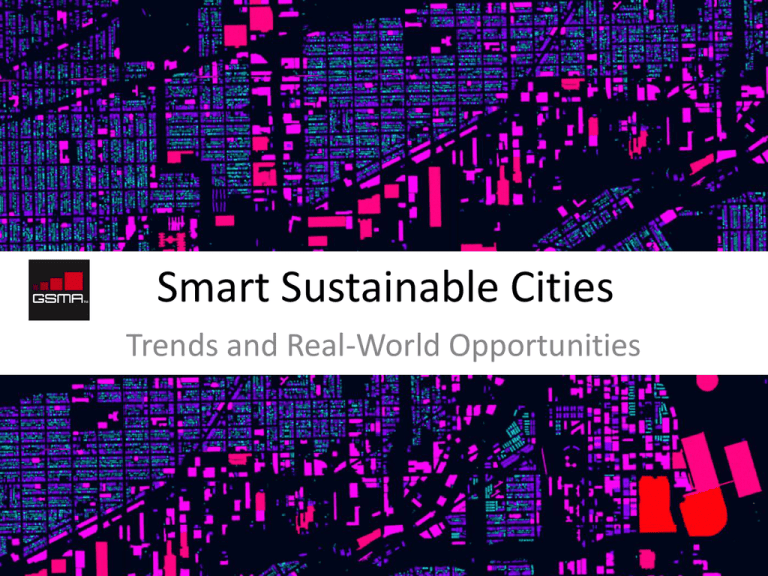
Smart Sustainable Cities Trends and Real-World Opportunities Role Of The GSMA WE ARE THE GLOBAL INDUSTRY VOICE SHAPING THE FUTURE OF MOBILE INDUSTRY FORUM POLICY ADVOCATE MARKET THINK TANK BUSINESS CATALYST Enabling industry collaboration and consensus Promoting policies that foster growth and investment Delivering insight and analysis from global industry data Serving the global mobile ecosystem through events such as Mobile World Congress and Mobile Asia Expo © GSMA 2013 GSMA and Smart Sustainable Cities global and regional technology trends – Mobile connections and M2M defining a ‘smart sustainable city’ – Challenges of urban living – Solutions and definitions – Importance in today’s context partnerships and possibilities – Case studies across borders and verticals © GSMA 2013 Macro Trends Continued Growth In Mobile Global SIM-enabled connections reached 6.9 billion in 2013 and are expected to reach 9.2 billion by 2020 (excluding M2M) Global subscribers reached 3.4 billion in 2013 and are expected to reach 4.3 billion by 2020 Source: The Mobile Economy Report 2014, GSMA, February 2014 © GSMA 2014 Asia Pacific – 3.5 billion Mobile Connections in 2013 © GSMA 2013 Source: GSMA Intelligence, Q2 2013 … And The Growth Trajectory Continues For 2014 © GSMA 2013 Source: GSMA Mobile Economy 2014, Asia Pacific, June 2014 Increased Mobile Broadband Connections Mobile operators across the Asia Pacific region have invested US$ 430 billion over the past six years, equivalent to 20% of revenues over the period. This has helped to improve network coverage (especially in remote areas), increase network capacity to accommodate growth in the subscriber base as well as accelerating levels of data growth. Capex levels are forecast to grow at just over 5% per annum out to 2020. © GSMA 2013 Asia Towards 2020 | M2M Playing A Key Role • China is already the world’s leader in M2M (GSMAi). • Asia will be the most connected region by 2020 (PwC). © GSMA 2013 Defining Smart Sustainable Cities Urbanization Still on the Rise in APAC © GSMA 2013 Modern Mega-Cities Face Great Challenges – Population growth – Waste disposal – Traffic congestion – Energy usage – Pollution – Economic growth © GSMA 2013 – Food supply – Aging infrastructure – Education – Employment – Clean water – Health Challenges Beget Opportunities © GSMA 2013 Cities are increasingly looking to become “smarter” © GSMA 2013 “Smart Cities” covers a broad range of application © GSMA 2013 Mobile As A Key Enabler Smart sustainable cities are built on certain key success factors: – Building productive partnerships – Smart interoperable ICT – Capture and distribute actionable data – Focus on solving specific problems – Role of mobile network operators © GSMA 2013 Services and Geographical Breakdown © GSMA 2013 Examples of Smart City Deployments © GSMA 2013 Productive Partnerships Will Drive Adoption In several smart city programmes tracked by the GSMA, the public sector helped finance early projects and city administration helped reconcile commercial & public policy objectives Santander, Spain: Using research funds from the EU, a consortium of 25 partners led by Telefonica turned the coastal town into a smart city laboratory. Busan, South Korea: A collaboration between Busan Metropolitan City, Cisco and KT shared the costs and risks associated with building a cloud-based Green u-City project. However, sometimes innovative companies need to take the lead Friedrichshafen, Germany: Deutsche Telekom built its own smart city ecosystem that can be replicated in projects across multiple different cities. This was demonstrated through its advanced smart metering project in Friedrichshafen, which has yielded substantial insights into mobile network operator roles. © GSMA 2013 Case Studies from Across Asia © GSMA 2013 China | Automotive | Mobile Telematics © GSMA 2013 India | Energy | Smart Metering © GSMA 2013 South Korea | Education | Mobile Learning © GSMA 2013 Japan | Healthcare | Remote Monitoring © GSMA 2013 Mobile is facilitating an exciting future for us The mobile network is at the ‘heart’ of building a more ‘connected’ future for all of us. As the mobile ecosystem continues to evolve both globally and in Asia, we will see a number of new things - new services, new technologies, new business models – that can help improve the lives of our citizens. Key to all this is ensuring that there is a clear, stable, transparent, consultative and predictable telecoms policy and regulatory environment – one that supports continuous investment into infrastructure and innovation. • Spectrum harmonisation for mobile broadband can unlock US$1 trillion in GDP for Asia Pacific • Cross-sector collaboration and smart partnerships will be a key enabler • Supporting innovation with a common position on intellectual property rights is important to encourage the continued momentum of the sector © GSMA 2013 GSMA Resources © GSMA 2013 THANK YOU © GSMA 2013
